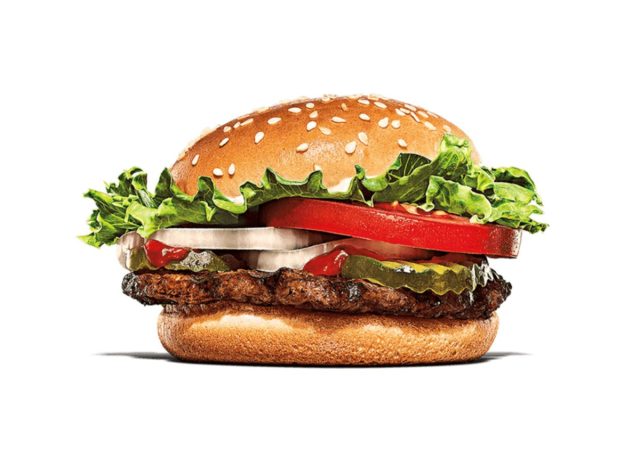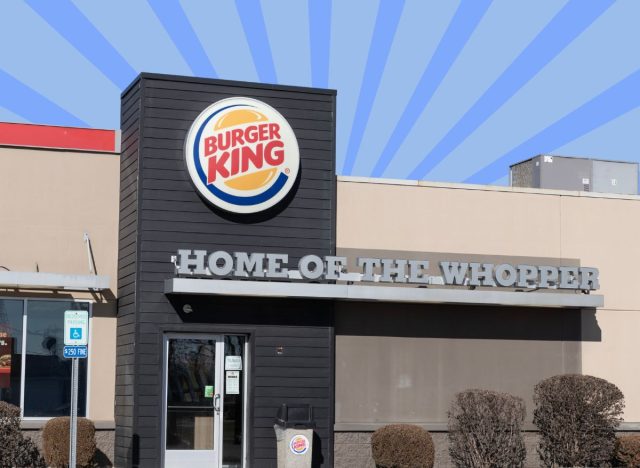In a world where convenience often trumps health concerns, finding nutritious options at fast-food chains can feel like an insurmountable challenge, especially when aiming to lose weight. Burger King, known for its flame-grilled burgers and indulgent sides, might not seem like a go-to destination for those watching their waistlines. However, with careful consideration and strategic choices, navigating the menu and finding options that align with your weight-loss goals is possible. We’re here to share the best Burger King lunch order for weight loss and pro tips to keep in mind when ordering at this fast-food chain.
The Whopper Jr. Burger is the best Burger King lunch order for weight loss.

The Whopper Jr. stands out as one of the best menu options at Burger King for those aiming to lose weight due to its relatively smaller portion size and balanced nutritional profile. Compared to its larger counterparts, such as the classic Whopper, the Whopper Jr. offers a satisfying burger experience with around 321 calories and 11 grams of fat. It also provides 15 grams of protein. (For context, the Whopper has 670 calories and 41 grams of fat.)
With a flame-grilled beef patty, fresh lettuce, tomato slices, crunchy pickles, onions, and tangy ketchup on a toasted sesame seed bun, the Whopper Jr. provides a satisfying combination of flavors without excessive calorie intake. So when the fast-food craving hits, be sure to opt for this menu choice!
Tips to keep in mind when ordering at Burger King:

Losing weight while eating at Burger King or any fast-food restaurant can be challenging, but it is possible with some mindful choices. Here are five tips:
1. Choose grilled over fried.
Choosing grilled burgers over fried chicken options can be a smart move when trying to reduce calorie and fat intake. While fried chicken is often breaded and then deep-fried, adding extra calories and unhealthy fats, grilled burgers are typically cooked without breading and excess oil, making them a leaner choice.
2. Skip the extras.
Skipping high-calorie toppings like cheese, bacon, and mayo can significantly reduce your meal’s calorie and fat content. Cheese and mayo, in particular, are high in saturated fats, which can contribute to weight gain and increase the risk of heart disease when consumed in excess. Additionally, bacon can add unnecessary calories and unhealthy fats without offering much nutritional value.
By choosing mustard, ketchup, lettuce, and tomato instead, you can add flavor to your burger without significantly increasing its calorie or fat content.
3. Watch your portions.
Watching your portions is crucial when trying to lose weight, as overeating, even on healthier options, can lead to consuming more calories than your body needs. Choosing smaller sizes or kids’ meals can help you control your portion sizes and prevent overeating.
Smaller sizes typically contain fewer calories and less fat than their larger counterparts, making them a better weight-loss choice. Kids’ meals, in particular, are often designed to be more calorie-appropriate for smaller appetites, offering a balanced meal with a main item, a side, and a drink.
4. Sides matter.
While fries are a popular and tasty option, they are often high in calories, fat, and sodium, especially when served in large portions. Opting for healthier alternatives like a side of fruit can help reduce calorie and fat intake while providing a satisfying side dish.
5. Drink wisely.
Sugary drinks like regular sodas, sweet tea, and milkshakes can add a substantial amount of calories to your meal without providing much nutritional value. By opting for healthier alternatives, you can save calories and make a more nutritious choice.
Water is always a great option as it has zero calories and helps keep you hydrated. Adding a slice of lemon or lime can add flavor without adding calories. Unsweetened iced tea is another good choice, providing a refreshing drink without the added sugars found in sweet tea.

